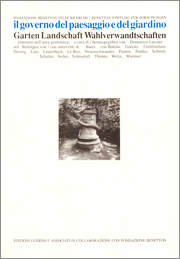
Il governo del paesaggio e del giardino / Garten Landschaft Wahlverwandtschaften
Itinerario nell’area germanica
edited by Domenico Luciani
Fondazione Benetton Studi Ricerche-Guerini e Associati
Treviso-Milan 1993
XXIV-248 pages
153 illustrations black and white
cover price 35.11 euros
ISBN 88-7802-427-9
(Memorie, 3; out of print)
[Stewardship of landscape and gardens. Approaches in the German area]
This volume gathers together, in Italian and in German, a selection of materials and reflections that emerged from the holding of the second seminar on the stewardship of landscape and gardens held from 26th August to 7th September 1991. It presents just one of the thousand possible itineraries in landscape design in Germany, explored during the two years between the summer of 1991 and the summer of 1993. This chronological specification is necessary, because we planned the seminar during the most critical phase of German reunification and concluded the selection of materials at a time when German society seemed traversed, if not by an actual crisis of rejection, at least by some difficulty in digesting its demands. Not so much in terms of the quantity of investments, but more fundamentally in terms of the quality of the “necessary mutations” to tackle growing ethnic tensions and new depths of marginalization after the implosion of the system of real socialism and the terrible Balkan explosion. The German world now seems like a gigantic “forge”, a test-bed simultaneously struggling with the need to conserve the historical heritage; guide the transition of whole landscapes from the industrial to the post-industrial era; give quality to the peripheries of the big cities; open up renewed space for nature without compromising the efficient functioning of the territory and without ceasing to cultivate the myth of development in compatible forms; in short, the need to pursue, in an ambitious way, the rediscovery, in landscape renewal, of an inventive mediation between nature and development, between the protection and use of the environment and of the territory. To be sure, the speed and density of the geopolitical changes taking place do not help us to find points of orientation in this forge, to grasp its humours, to choose the cases consistent with the disciplinary perspective of “stewardship”, and hence to understand what forms should be taken, in this cultural and normative context, by the sum of powers and capabilities that guide the modifications of significant parts of the environment and the territory, and that superintend the quality (and its renewal in time) of those places rich in nature and culture that we call “outstanding sites”. Nonetheless the most serious difficulties remain those due to long-term and deeply rooted diversities. Differences not just of “landscape culture”, but of the “feeling for nature” thus remain, and in some respects are being aggravated; they are being translated into a genuine linguistic gap, a disconnect between educational and professional systems, between structures of administrative powers, regulations and practices, too different to be compared or reconciled. We cannot as yet understand, of course, whether, and how far, this forge will produce results geared to the public and private energies at our disposal. What we can immediately grasp, however, is that it is an experience that consciously aims to offer a common basis of reflection to anyone involved in territorial planning; and that it can show the improvement in quality that may derive from taking on board the values of environment and landscape. It can also show anyone responsible for achieving a harmonious environment how to gauge the compatibility of the changes taking place; or anyone involved in landscape conservation how to go beyond the academic exercise of the project concluded, by striving to give (or restore) quality to the changes taking place. At the end of the twentieth century, this attempt, with all its parameters and constraints, helps us to understand the German forge, the titanic gambles, and the difficulties and complexities, the contradictory tensions and inventive forces that denote it. We would like to be long-term witnesses of what miracles Amphion’s lyre may achieve within these extreme challenges of Prometheus.
Contents
Domenico Luciani, Il paese di Anfione, il paese di Prometeo, VII
I. Nuove dimensioni del paesaggismo
Hermann Baier, Pianificazione paesistica in Baviera, 3
Arno S. Schmid, Il paesaggio dell’Emscher per l’IBA 1989-1999, 17
II. Esperienze di “giardino-natura”
Louis G. Le Roy, Un’eco-cattedrale a Mildam, 29
Eduard Neuenschwander, Il parco dell’Università di Zurigo (Irchel) , 37
III. Siti della memoria
Adrian Von Buttlar, Il trascendente nel giardino paesaggistico, 47
Iris Lauterbach, Feste e celebrazioni nei giardini del XVIII secolo, 63
Heiko K.L. Schulze, Il cimitero Ohlsdorf di Amburgo, 83
IV. Questioni di conservazione
Michael Goecke, Modalità di governo dei parchi e dei giardini storici, 105
Rainer Herzog, Il ”Parkpflegewerk”: l’esempio di Nymphenburg a Monaco, 111
Günther Thimm, I parchi storici della Turingia, 129
Hubert W. Wertz, Il ”Parkpflegewerk” di Schwetzingen, 141
V. BUGA, IGA
Hendrik Gottfriedsen, Bundesgartenschauen a Berlino 1985 e 1995, 157
Helga Panten, Storia delle Bundesgartenschauen, 65
Klaus D. Pantke, IGA 1993, Stuttgart, 177
VI. Il caso Berlino
Clemens A. Wimmer, Parchi e giardini storici a Berlino, 189
Michael Seiler, Pfaueninsel e Glienicke a Berlino, 201
Antje Solmsdorf, I parchi popolari a Berlino-Wedding, 213
VII. Referenze
Referenze sugli autori, 227
Referenze su siti, 229
Referenze su enti e istituzioni, 230
Referenze sulla formazione scolastica, con un intervento di Peter Latz, 231
Indice dei nomi e dei luoghi, 239
